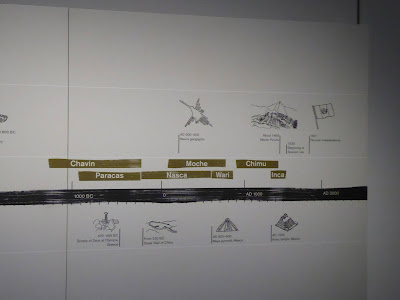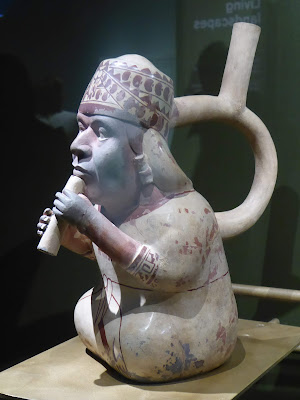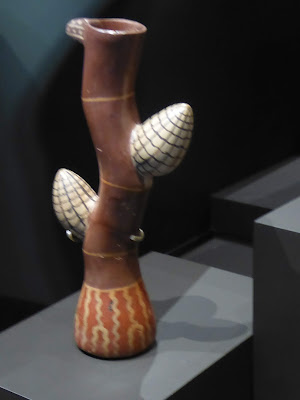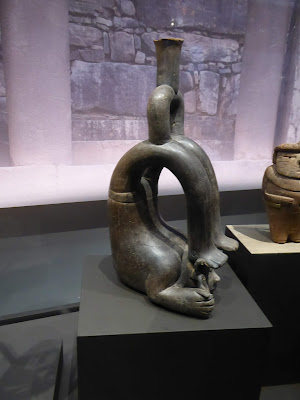In early December I went to an exhibition at the British Museum called: Peru: a journey in time. Through pottery, ceramics and textiles it showed the development of ancient civilisations from Central Andean cultures. Without the written word these items tell us much about the customs and rituals of those times. I visited Peru in 2009, so I was particularly interested in seeing this fascinating insight into civilisations I had no idea existed. I have tried to include descriptions and related information from the Museum display.
This timeline gives you some idea of the periods in history to which these items refer.
Funerary mask. Copper and shell, Moche, AD 100-800
Musician playing a flute: Painted pottery, Moche, AD 100-800
Tasselled band with feather motifs: Cotton with llama/alpaca wool, Chimu AD900-1470
Llama container, painted pottery, Mocha AD100-800
Yucca vessel, moulded and painted pottery. Moche, AD100-800
Bottle in the shape of a mythological mountain scene. Painted pottery, Moche AD 400-700
Stepped triangle vessel. This represents the mountains whilst the crest at the top symbolises water flowing through the river valleys to the sea. Moche, AD 100-800
Deer vessel, painted pottery, Moche, AD 100-800
Human deer vessel. Painted pottery, Moche AD 100-800
Maize was first grown in the Andes around 6000 years ago and has been part of people's basic diet ever since. Maize plant vessel, painted pottery, Nasca 100 BC-AD 650
Deity holding maize, painted pottery, Mocha AD 100-800
Feline. moulded, painted pottery, Moche, 200 BC-AD 500
Snake, moulded, painted pottery, Moche, 200 BC-AD 500
Bird, moulded, painted pottery, Moche 200 BC - AD 500
Ear plates with feline features. Gold alloy, semi precious stones, shell and mother of pearl. 800-550 BC
Headdress with mythical feline heads. Gold alloy, 800-550 BC
Bird shaped whistle, painted pottery, Nasca, 100 BC - AD 650
Man and woman having sex. Painted pottery, Nasca 100 BC - AD 650
Women wearing cape with intricate design. Painted pottery, Nasca 100 BC- AD 650
Shell with a woman's face, Nasca 100 BC - AD 650
Nasca vessel showing eight women seated around three vessels.
Ceremonial drum painted with mythical scenes.
Bowl with painted severed heads. Pottery, Nasca 100BC - AD 650
Severed human head vessel.
Figure holding a severed head.

Vessel depicting a figure holding a lime container and dipper. Moche AD 200-600
Vessel depicting a figure holding a lime container. Moche AD 200-600
Lime container and dipper. Gourd, leather and wood. Central coast 1400-1532.
Vessel with modelled representations of shells Pottery, Inca 1400-1532.
Ear plug showing a mythical figure. Wood and mother of pearl and shell, 1300-50
Prisoner in front of a ruler and vessel in the shape of a prisoner.
Sleeping Moche warrior with nose ring, patterned helmet, uniform and large circular ear plates.

In 1821 Peru gained independence from Spain. Today the country reflects a combination of cultures, religions and transformations. Despite centuries of colonial repression and Western influence, many Central Andean beliefs and practices live on. I hope you enjoyed seeing this exhibition through my eyes.

































































Astonishing imagination and workmanship. I'd love to have seen those exhibits in person.
ReplyDeleteThese are fascinating artistic historical artifacts. Sacrificing to the gods, beheadings … so much violence associated with some stories we tell to explain existence.
ReplyDeleteThank you so much for taking the time to write and chronicle the pieces so well. It's fascinating.
ReplyDeleteThat was an extensive collections of artifacts from various civilizations in Peru. I recognized the Civilization names having read articles in Archaeology Magazine that featured some of them. The pottery is so intricate and imaginative. Thanks for the tour. Can't remember when I was last in a museum. Maybe Fall of 2019 when we were in Barcelona.
ReplyDeleteThe artefacts are in such remarkably good condition and so beautifully decorated. I am amazed.
ReplyDeleteWhat a great exhibition. Thank you for taking the time to not only visit but then to share so much here.
ReplyDeleteI am so glad you added the dates next to each pottery object. The deer, maize, deity, prisoner etc were beautifully done, even more so because the dates (100-800 AD mainly) were much earlier than Europeans would have expected.
ReplyDeleteI see, that now we have to travel through museums at least you had been theren, but not I, so it's very interestinng. I think that it's a good idea in the museum it's warmer then outside and it's not wet either. If only I would have a bit more of energy !
ReplyDeleteAmazing how they can analyze what was carried in such an old bag! We have friends leaving for a tour of Peru next week. Fingers crossed it’s not cancelled.
ReplyDeleteI really enjoyed seeing the pottery pieces. Amazing that something from 100~800 AD is found in such good condition. The sleeping Moche warrior is so beautifully done. At the crèche exhibit I went to in December Peru was represented with figures so much like these, although they were recently made! I will see if I can find a photo to show you to compare.
ReplyDeleteThat pottery is simply beautiful and quite mazing how it has survived the years so well. I wonder if you bought some reproductions for your own visit to Peru? I would definitely have done so.
ReplyDeleteYour photos of the collection are great. I love ancient pottery and this is afascinating exhibit.
ReplyDeleteBeautiful ceramics and the strange thing is that we were in a museum in Turkey once and they had nearly the same ceramics with those pouring spout on the head or in the handle unearthed somewhere in the eastern part of the country.
ReplyDeleteThose are really beautiful and fascinating about a culture that I do not know well. I've heard that the British Museum is a really wonderful place and I hope to go there someday. It's just amazing that there is free entry! I wish New York museums were free to enter.
ReplyDeleteThis is an amazing exhibition. It's so surprising to me how much has been learned about this ancient civilization without books and writing from that time.
ReplyDeleteFascinating artefacts and information.
ReplyDeleteFascinating exhibit and photos ~ Xo
ReplyDeleteWishing you a Happy Day,
A ShutterBug Explores,
aka (A Creative Harbor)
Very interesting artifacts!
ReplyDeleteWhat a an amzing exhibition. I loved those first ear plates, atlhuugh they look morelike hand covers to me.
ReplyDeleteThank you so much for this post.
ReplyDeleteIt was very interesting seeing all of your photographs, some amazing exhibits.
All the best Jan